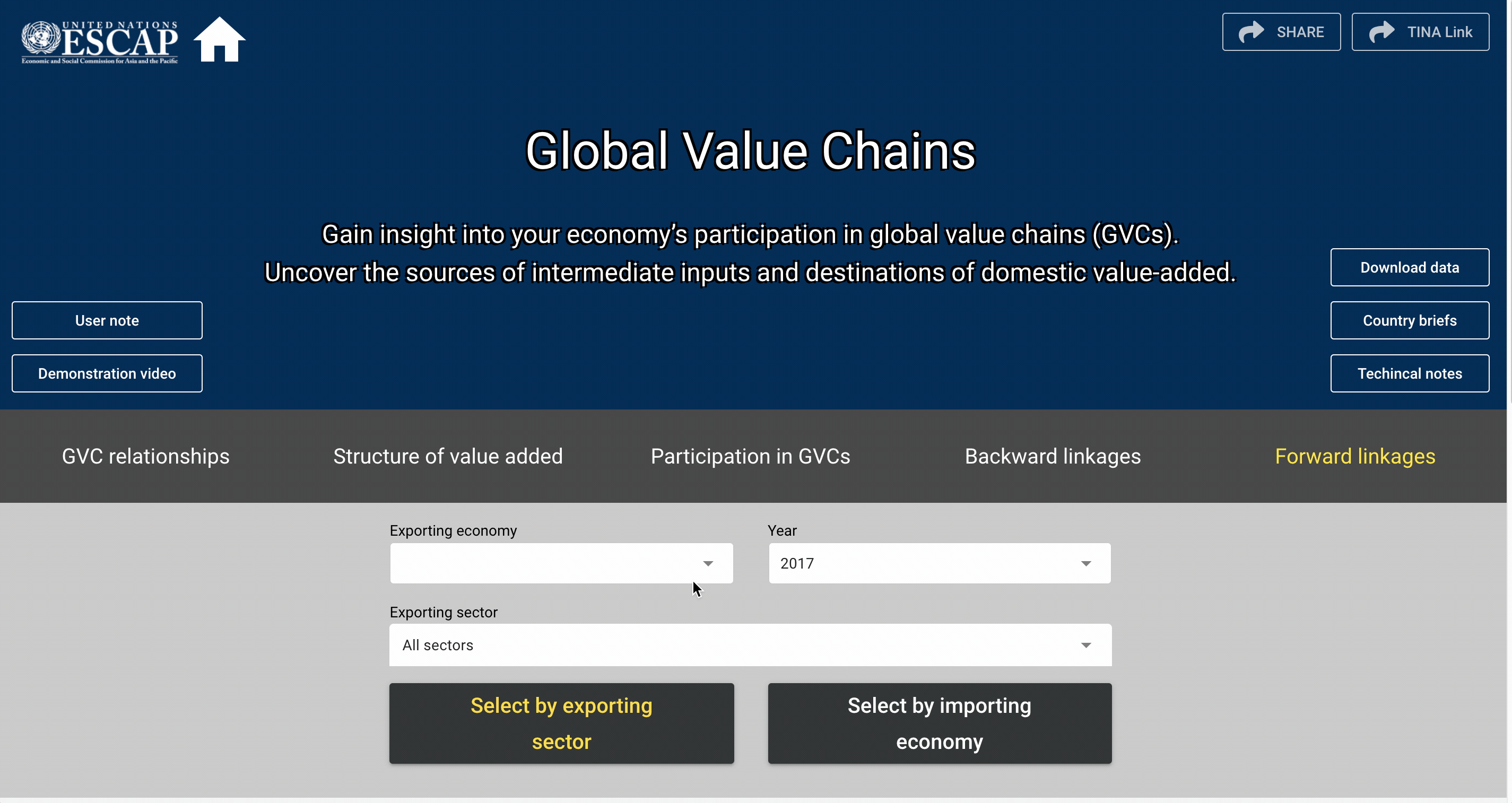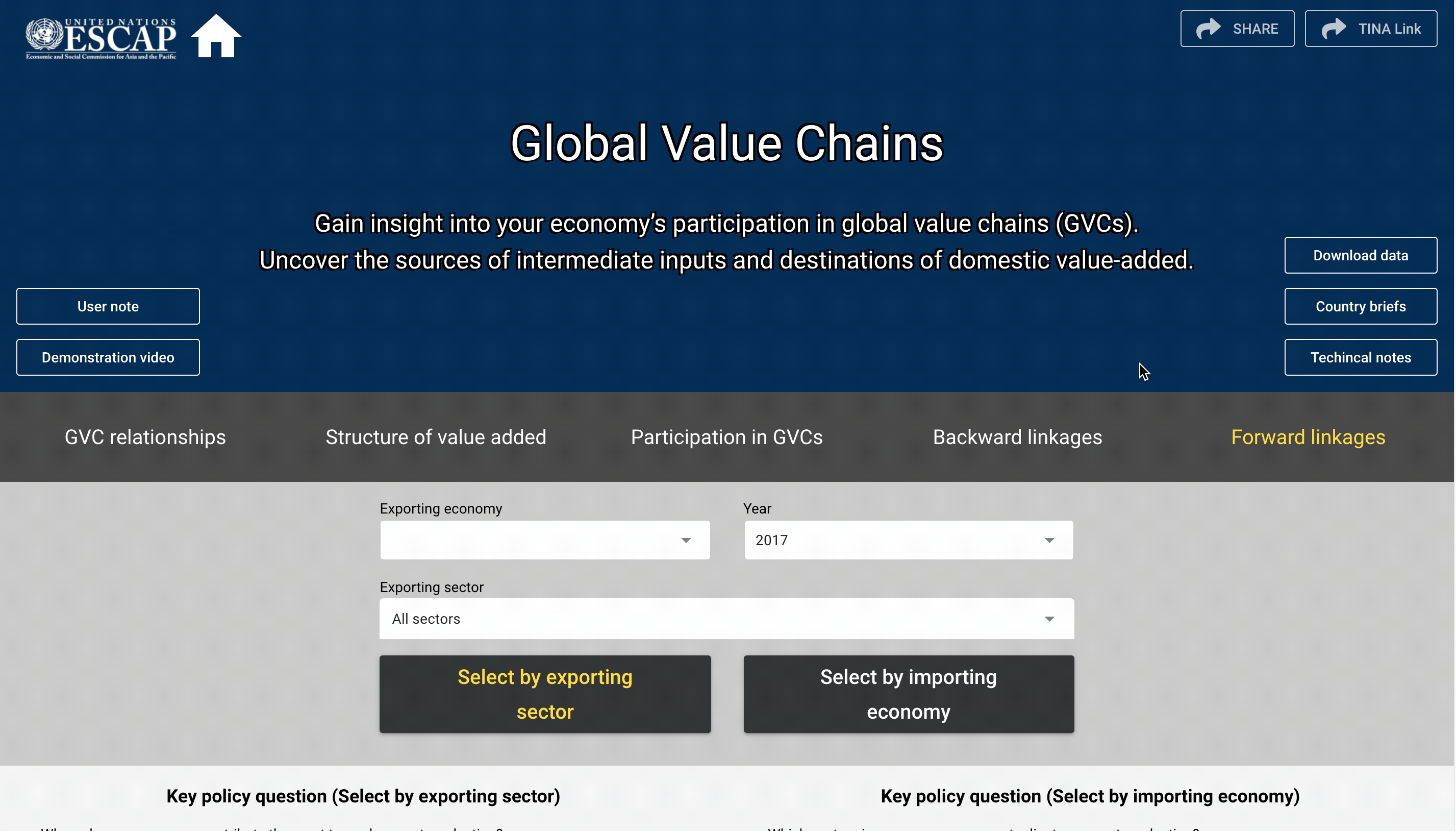5 Forward linkages
The objective of this section of RIVA is to provide insight into an economy’s forward linkages, i.e. to describe where an economy’s exports contribute towards further export production and how different exporting sectors are involved in this contribution to export production in other countries. This helps highlight the structure of dependence an economy has on export production in other countries and the sectoral pattern of these forward linkages.
In this example, let us consider Thailand’s forward participation in its exports to the world. Have a closer look at the Forward linkages section on the website to find out more about Thailand’s forward linkages, or any other economy you may be interested in.
This section of RIVA has two sub-sections, namely ‘Select by exporting sector’ and ‘Select by importing economy’.
5.1 By exporting sector
To examine Thailand’s forward linkages by exporting sector, click on the ‘Forward linkages’ section on the navigation bar. From here, choose your exporting economy on interest (in this example, Thailand) the drop-down menu, as shown below:

Figure 5.1: Forward linkages, by exporting sector: Choosing exporting economy
You can change the year of interest or exporting sector in a similar manner. In this example, we maintain the pre-selected year, i.e. 2017, and the pre-selected exporting sector, i.e. ‘All sectors’.
The first visualization you will see after making these sections is shown below:
This tree map visualization contains a number of useful details. To begin with the question at the top of the graph already gives you an indication of what to expect: ‘Where does Thailand contribute the most towards export production (all sectors)?’. To break this question down, Thailand is the exporting economy of interest and we are considering its forward linkages for ‘All sectors’ (our chosen exporting sector). Most importantly, we are concerned with where Thailand’s exports are used in further export production.
The visualization provides a number of useful insights, described below:
You can examine the breakdown of destinations of forward linkages by region and country. For example, we can see that Asia-Pacific (in blue) is the largest destination of Thailand’s exports that are used in further export production. Moreover, China accounts for 7.18% of total imported content used in Thailand’s exports to the world. Hover your mouse over the China section to see more details: you will see this amounts to $2.8 billion.
In a similar manner, you can examine any section of the tree map for any of the economies shown to get more details on Thailand’s forward linkages with a particular economy.
There is also an explanatory paragraph between the question and the tree map that further assists users in interpreting the results shown in the graph.
Below this explanatory paragraph, in the top left corner of the graph, are 2 additional values that complement the results in the graph. The first (Thailand’s contribution to export production: $39.56 billion) is simply the sum of all the $ values in the tree map, i.e. the total value of Thailand’s exports to the world that are used in further export production. The second (Thailand’s gross exports to World: $238.86 billion) is self explanatory. Comparing these two values helps contextualize the importance of forward linkages for Thailand’s exports to the world.
You can download the graph and underlying data by simply clicking on the three horizontal bars icon on the top right corner of the graph and choosing your preferred format for download.
The second visualization you will see scrolling down on this page is shown below:
This bar graph is designed to help you compare the results for Thailand’s forkward linkages with equivalent results for all other economies in the same sub-region (in this case South-East Asia). At first glance, the graph shows you the share that forward linkages account for in gross exports to the world across all South-East Asia economies. This highlights that Brunei Darussalam and Lao PDR have the largest backward linkages (over 25% of gross exports to the world) while Singapore and Viet Nam have the smallest (under 15% of gross exports to the world).
There are also a number of additional insights that this graph offers us through its interactive features. Simply hover your mouse over any of the bars in the graph to see relevant information:
For example, hover your mouse over the blue bar (Asia-Pacific) for Philippines. You will see that Philippines’ contribution to export production in Asia-Pacific account for 9.39% of its gross exports to the world. This is also shown in absolute terms ($6.9 billion).
You can also drill-down into this bar to see which particular economies in Asia-Pacific are the destinations of Philippines’ forward linkages. To do this, simply click on the blue bar for Philippines. This will drill-down into a pie chart showing the value of Philippines’ exports that are used by individual Asia-Pacific economies for their own export production. Hover your mouse over an economy to see more details: considering Japan, the value 1.84% ($1.4 billion) indicates the share of Philippines’ gross exports to the world that are used in further export production. Click the button in the top right corner of the graph that says ‘Back to Asia-Pacific’ to return to the bar graph with all South-East Asia economies.
In a similar manner, you can undertake a detailed examination of the regional structure of any South-East Asia economies’ forward linkages.
You can also click on any of the legend items to remove a selected region from the graph. Click it again to add it back in.
Finally, you can also download the graph and underlying data by simply clicking on the three horizontal bars icon on the top right corner of the graph and choose your preferred format for download.
5.2 By importing economy
We now move to examining Thailand’s forward linkages by importing economy. More specifically, this section will describe the sectoral structure of Thailand’s forward linkages with a selected importing economy. Click on the ‘Select by importing economy’ button in the ‘Backward linkages’ section of RIVA. From here, choose your exporting economy of interest (in this example, Thailand) and importing economy (in this example, ‘World’) from the drop-down menu as shown below:

Figure 5.2: Forward linkages, by importing economy: Choosing exporting and importing economies
You can change the year of interest in a similar manner. In this example, we maintain the pre-selected year, i.e. 2017.
The first visualization you will see after making these selection is shown below:
This tree map visualization contains a number of useful details. To begin with the question at the top of the graph already gives you an indication of what to expect: ‘How is Thailand’s contribution to export production in World distributed across sectors?’. To break this question down, Thailand is the exporting economy of interest and we are considering its exports to the World ( our chosen importing economy). Most importantly, we are concerned with how different exporting sectors in Thailand contribute towards export production in the World.
The visualization provides a number of useful insights, described below:
You can examine the breakdown of how different exporting sectors in Thailand contribute towards export production in the World. For example, we can see that Manufacturing: high and medium tech (in red) is the largest contributor towards export production in the World in absolute $ terms. Specifically, we can see that Basic metals (11.49%) is the exporting sector in Thailand that contributes the most towards export production in the World. Hover your mouse over the Basic metals section to see more details: you will see this amounts to $4.54 billion.
In a similar manner, you can examine any section of the tree map for any of the exporting sectors shown to get more details on Thailand’s sectoral contribution to further export production in the World.
There is also an explanatory paragraph between the question and the tree map that further assists users in interpreting the results shown in the graph.
Below this explanatory paragraph, in the top left corner of the graph, are 2 additional values that complement the results in the graph. The first (Thailand’s contribution to World’s export production: $39.56 billion) is simply the sum of all the $ values in the tree map, i.e. the total value of Thailand’s exports to the world that are used in further export production. The second (Thailand’s gross exports to World: $238.86 billion) is self explanatory. Comparing these two values helps contextualize the importance of forward linkages for Thailand’s exports to the world.
You can download the graph and underlying data by simply clicking on the three horizontal bars icon on the top right corner of the graph and choosing your preferred format for download.
The second visualization you will see scrolling down on this page is shown below:
This bar graph is designed to help you compare the results for Thailand’s forward linkages with the World, with equivalent results for all other economies in the same sub-region (in this case South-East Asia). At first glance, the graph shows you the share that forward linkages account for in gross exports to the selected importer (in this case, World) across all South-East Asia economies. This highlights that Brunei Darussalam and Lao PDR have the largest forward linkages (over 25% of their gross exports to world) while Singapore and Viet Nam have the smallest (under 15% of gross export to world).
There are also a number of additional insights that this graph offers us through its interactive features. Simply hover your mouse over any of the bars in the graph to see relevant information:
For example, hover your mouse over the red bar (Manufacturing high and medium tech) for Malaysia. You will see that Malaysia’s high and medium tech manufacturing exports to the world that are used in further export production account for 10.64% of Malaysia’s gross exports to the world. This is also shown in absolute terms ($23.7 billion).
You can also drill-down into this bar to see which particular sectors in Malaysia’s Manufacturing high and medium tech contribute the most towards further export production in the World. To do this, simply click on the red bar for Malaysia. This will drill-down into a pie chart showing the value for individual sectors within Malaysia’s high and medium tech manufacturing sector. Hover your mouse over a sector to see more details: considering Computer electronic and optical equipment, the value 6.17% ($13.74 billion) indicates the share of Malaysia’s gross exports to the World that are used in further export production. Click the button in the top right corner of the graph that says ‘Back to Manufacturing high and medium tech’ to return to the bar graph with all South-East Asia economies.
In a similar manner, you can undertake a detailed examination of the sectoral structure of any South-East Asia economies’ forward linkages in exports to the World (or any importing economy of your choice).
You can also click on any of the legend items to remove a selected sector-group from the graph. Click it again to add it back in.
Finally, you can also download the graph and underlying data by simply clicking on the three horizontal bars icon on the top right corner of the graph and choose your preferred format for download.